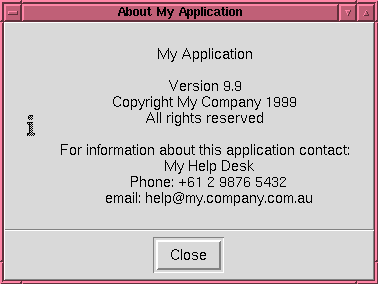

Pmw.AboutDialog() - window to display version and contact information
An about dialog is a dialog window which displays information about the application, such as name, version, copyright and contact details.
The text of the message is constructed from the application name
(given by the applicationname option) followed by the values
supplied in the most recent calls to Pmw.aboutversion(),
Pmw.aboutcopyright() and Pmw.aboutcontact() functions.
The icon of the message defaults to 'info', but may be changed using the icon_bitmap component option.
activate(). The default is None.
If the value of command is not callable, the default behaviour
is to deactivate the window if it is active, or withdraw the
window if it is not active. If it is deactivated, deactivate()
is called with the button name or None as described above. The default is None.
deactivate(). The default is None.
activate() method to control whether the
window is made transient during modal dialogs. See the
activate() method. The default is 'parent'.
(hull_borderwidth = 1, hull_relief = 'raised'). By default, this component is a Pmw.ButtonBox.
(borderwidth = 1, relief = 'raised'). By default, this component is a Tkinter.Frame.
class Demo:
def __init__(self, parent):
# Create dialog.
Pmw.aboutversion('9.9')
Pmw.aboutcopyright('Copyright My Company 1999\nAll rights reserved')
Pmw.aboutcontact(
'For information about this application contact:\n' +
' My Help Desk\n' +
' Phone: +61 2 9876 5432\n' +
' email: help@my.company.com.au'
)
self.about = Pmw.AboutDialog(parent, applicationname = 'My Application')
self.about.withdraw()
# Create button to launch the dialog.
w = Tkinter.Button(parent, text = 'Show about dialog',
command = self.execute)
w.pack(padx = 8, pady = 8)
def execute(self):
self.about.show()
![]()
Pmw 1.3 -
6 Aug 2007
- Home
Manual page last reviewed: 18 May 2002